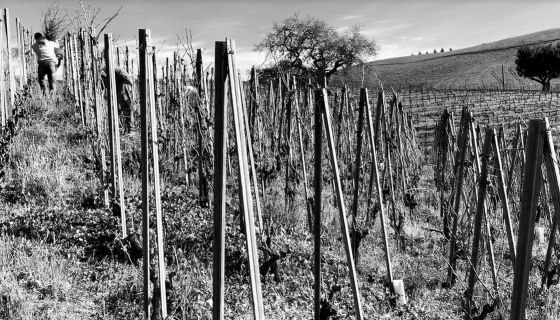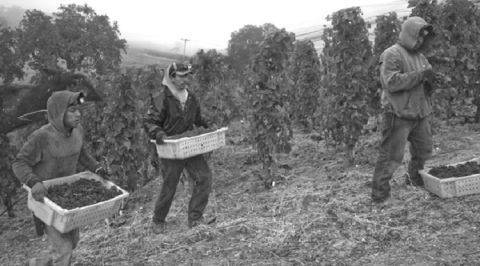Being a lifelong hospitality professional, the COVID-19 pandemic has redefined the way I think about the term sustainability. Over the last five months the coronavirus has turned the American food and wine industry on its head, leaving workers across all aspects of our business uncertain where their next paycheck will come from. In California, where wineries have been overwhelmingly reliant on migratory agricultural workers from Mexico and Central America, the virus has left the 2020 harvest in a lurch.
Approval of the H2-A visas required for agricultural workers to enter the United States is a process perennially fraught with delays. The coronavirus has only exacerbated issues at the border, leaving some vineyard owners prepared to throw in the towel on the 2020 vintage altogether. Peter Stolpman, second generation owner of Stolpman Vineyards in Santa Barbara County, understands the immense pressure these migratory harvesters are under. Describing it as a ‘global issue in the world of wine’ that vineyard workers are accustomed to living without health insurance or paid sick leave. He claims that ‘just being in California, you immediately become aware of the migrant agricultural worker situation. You’d really have to actively ignore it not to notice.’
The commitment to sustainable labor practices has been at the core of Stolpman Vineyards mission from the very beginning. Peter Stolpman’s father, Tom, was aware of how ambitious his dream to establish a world class vineyard site on Ballard Canyon’s limestone hills truly was. Unlike the exploding markets of Napa and Sonoma, Santa Barbara was not home to many heralded vineyards in the 1980s. The purchase of a 228-acre ranch on which to build said vineyard was not one Tom took lightly. Stolpman recalls his father musing about this dream over the course of a decade. He knew ‘if his dream was going to come true, he was not cutting corners. If this was going to work, it had to be an unbelievably positive movement for everyone involved.’ With that resolution in mind, Tom established his vineyard with a pledge that is still groundbreaking 29 years later: all vineyard workers would be employed full-time, year-round.
At the heart of Stolpman Vineyards is the vineyard crew, which is affectionately known as La Cuadrilla. Derived from the Spanish term for a vineyard block, cuadra, La Cuadrilla serves not only as the name of their vineyard team but also one of Stolpman Vineyards most delicious wines. While its exact composition varies from vintage to vintage, La Cuadrilla is a bright, juicy, and refreshing blend of Syrah, Grenache, and Sangiovese. The wine was born out of an idea Ruben Solorzano, Stolpman’s partner and vineyard manager, had in the late 90s. Stolpman recalls Ruben’s desire for the crew to ‘take ownership and become proficient in understanding the lifecycle of the vine.’
Ruben left the crew, without his expert guidance, responsible for farming a small cuadra in order to teach them hands-on about the lifecycle of the vine. After three years of giving the crew some practice, Tom took things further and bottled the fruit from these vines as its own wine for the crew to drink. Stolpman recalls the summer barbecues where he and the crew, quite literally, enjoyed the fruits of their labor. ‘The first vintages, about 15 to 20 cases per crew member, were just for them to drink, and at the time none of them really drank wine,’ said Stolpman. Upon the realization that this was far too much wine for the crew members to drink themselves, Stolpman Vineyards began selling La Cuadrilla to the public. Since then, the project has grown from its initial two-acre training block to a rotating selection of parcels chosen by Solorzano to produce a wholly unique blend each year.
When asked about the evolution of La Cuadrilla from a training tool to one of the stars of his portfolio, Stolpman explained how the modern version began with the 2009 vintage. It was that year on a Christmas vacation to Jalisco when Peter finally met the extended family of La Cuadrilla’s members. His eyes widened as he explained how ‘everyone knew the story of La Cuadrilla, how long their family had been a part of it, they knew all about me and my background. There was so much pride in their family having a career at Stolpman.’ It was there Peter understood the need for La Cuadrilla’s expansion. The crew has since grown from the founding 15 members to 28 full-time employees with no less than 10% of Stolpman Vineyards total production per vintage being devoted to the La Cuadrilla blend. 100% of the profits from every bottle of La Cuadrilla sold each year are returned to the crew members in the form of year-end bonuses.
However, the evolution of La Cuadrilla was not without growing pains, Stolpman remembers the ‘big mistake’ he made in 2009, his first vintage in charge. The fruit on the vine was perfectly ripe and healthy, but with rain in the forecast Stolpman made a quick decision. ‘I brought in another crew who worked with one of Ruben’s other vineyards to help us finish harvest’, he said with a sigh. Thrilled that he had beat out the rain, Stolpman quickly realized his own team was not happy. ‘It was a shot to their pride’ he recalled ‘this is their vineyard’. As Stolpman would soon learn, La Cuadrilla were willing to finish the harvest themselves by any means necessary. Since then, the winery has never hired an additional harvest crew and has implemented a number of strategies to ensure their harvest can be managed exclusively by their own crew.
Stolpman went on to cite this as one reason why his Combe label, a partnership between Stolpman Vineyards and acclaimed sommelier, author, and winemaker Rajat Parr, has worked so well. ‘[Parr] only wanted to plant early ripening varieties like Trousseau, Chenin Blanc, and Gamay, which ripen way before Syrah’ he explained. The varying encépagement on the property, compounded by a diverse array of vine densities and training methods, has allowed Stolpman Vineyards to space out their harvest workload. Beginning in August and in certain vintages finishing as late as November, the more even pace guarantees that La Cuadrilla can handle the harvest without needing an additional crew.
‘Our wines are defined by this group of people’, Stolpman emphasized. The very style and grape varieties he and Solorzano have chosen over the years has been influenced by the passion and commitment of their crew. Stolpman Vineyards’ top selling wine, a carbonic Sangiovese known as ‘Love You Bunches’ was born out of this dedication. Sangiovese, a grape not commonly grown in California, found its way to Stolpman Vineyards in an effort to support the crew’s wishes to farm the property without the help of additional workers.
As mechanization continues to become more prevalent in California vineyards thanks to the dwindling availability of labor, Stolpman is grateful all of his vines are still tended completely by hand. He credits the creation of their rapidly expanding ‘So Fresh’ brand, a line of crunchy, natively-fermented carbonic reds, to the crew’s ability to consistently deliver pristine, perfect fruit from the vines. ‘It's scary to think about [2020] if we didn’t have that fruit quality, if the crew hadn’t given us the opportunity to launch the So Fresh line, it would be a lot more difficult to weather COVID-19.’
Even with their own finely tuned system in place, Stolpman Vineyards continues to promote a healthier, forward-thinking wine growing community in Santa Barbara by serving as a training ground for aspiring young vignerons. Stolpman is proud ‘to provide other opportunities for young people, and they know if they put in two or three years at Stolpman, Ruben will promote them out to be foreman and managers at his other vineyards in Santa Barbara.’
The fact that great wines are made in the vineyard is an irrefutable narrative echoed around the world. Stolpman Vineyards has not only proven this principle to be true but demonstrated to the global wine community how it can evolve for the better. We must go beyond caring for our land and care even more about the people who work it. The 28 members of La Cuadrilla are able to plant roots, raise their children in a stable home, and hone their craft without ever fearing for their livelihood. As we closed our conversation, Stolpman’s only regret was that theirs is a ‘novel story to tell.’














